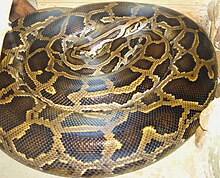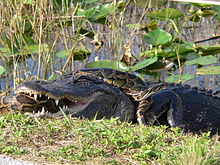Burmese python: Difference between revisions
m Reverted edits by 71.0.231.196 to last version by ClueBot NG (GLOO) |
|||
| Line 42: | Line 42: | ||
===Digestion=== |
===Digestion=== |
||
The digestive response of Burmese Pythons to such large prey has made them a model species for digestive physiology. A fasting python will have a reduced stomach volume and acidity, reduced intestinal mass and a 'normal' heart volume. After ingesting prey, the entire digestive system undergoes a massive remodelling, with rapid hypertrophy of the intestines, production of stomach acid, and a 40% increase in mass of the ventricles of the heart in order to fuel the digestive process. |
The digestive response of Burmese Pythons to such large prey has made them a model species for digestive physiology. A fasting python will have a reduced stomach volume and acidity, reduced intestinal mass and a 'normal' heart volume. After ingesting prey, the entire digestive system undergoes a massive remodelling, with rapid hypertrophy of the intestines, production of stomach acid, and a 40% increase in mass of the ventricles of the heart in order to fuel the digestive process. |
||
think did u know that this is written by people is how do u know that they know what they are talking about ? |
|||
[http://jeb.biologists.org/cgi/reprint/211/24/3767?maxtoshow=&HITS=10&hits=10&RESULTFORMAT=&author1=secor&andorexacttitle=and&andorexacttitleabs=and&andorexactfulltext=and&searchid=1&FIRSTINDEX=0&sortspec=relevance&resourcetype=HWCIT] |
|||
==Conservation== |
==Conservation== |
||
Revision as of 00:04, 10 February 2011
| Burmese Python | |
|---|---|

| |
| Scientific classification | |
| Kingdom: | |
| Phylum: | |
| Class: | |
| Order: | |
| Suborder: | |
| Family: | |
| Genus: | |
| Species: | |
| Subspecies: | P. m. bivittatus
|
| Trinomial name | |
| Python molurus bivittatus Kuhl, 1820
| |
The Burmese Python (Python molurus bivittatus) is the largest subspecies of the Indian Python and one of the 6 largest snakes in the world, native to a large variation of tropic and subtropic areas of Southern- and Southeast Asia. They are often found near water and are sometimes semi-aquatic, but can also be found in trees. Wild individuals average 3.7 metres (12 ft) long,[1][2] but may reach up to 5.8 metres (19 ft).[3]
Description
Burmese Pythons are light-coloured snakes with many brown blotches bordered in black down the back. The perceived attractiveness of their skin pattern contributes to their popularity with both reptile keepers and the leather industry. The pattern is similar in colour, but different in actual pattern to the African Rock Python (Python sebae), sometimes resulting in confusion of the two species outside of their natural habitats.
In the wild, Burmese pythons grow to 3.7 metres (12 ft) on average,[1][2] while specimens of more than 4 metres (13 ft) are uncommon.[4][5] Individuals over 5 metres (16 ft) – like a specimen from Cooch Behar with 5.8 metres (19 ft) and 91 kilograms (201 lb) [3] – are very rare.[4] There are reports of snakes more than 6 metres (20 ft) long, but those are often result of confusion between Burmese Pythons and Reticulated Pythons, stretched skins, or simple exaggeration. There are also dwarf forms on Java, Bali and Sulawesi. At Bali they reach an average length of 2 metres (6.6 ft) [6] and on Sulawesi they achieve a maximum of 2.5 metres (8.2 ft).[7]
Geographic range and habitat

The Burmese Python is found throughout Southern- and Southeast Asia including Eastern India, Nepal, Western Bhutan, Southeast Bangladesh, Myanmar, Thailand, Laos, Cambodia, Vietnam, Northern continental Malaysia, Southern China and in Indonesia on Java, Southern Sulawesi, Bali and Sumbawa.[8] This python is an excellent swimmer and needs a permanent source of water. It can be found in grasslands, marshes, swamps, rocky foothills, woodlands, river valleys, and jungles with open clearings. They are good climbers and have prehensile tails.
Invasive species


The captive breeding of Burmese Pythons in the Americas has led to some rather serious problems. People who grow tired of their pythons, or whose pythons have grown too large to be kept in their houses, have been known to release their pets into the wild rather than have them re-homed or even humanely euthanized. This has been particularly problematic in Florida, along with possible zoo and household escapees from Hurricane Andrew, where a large number of pythons have made their way to the Everglades.[9] They have thrived there, begun to reproduce prolifically, and become an invasive species. Over 1330 (US Natural Park Service website - Dec 31 2009[10]) have been captured in the Everglades. Since they have been known to eat endangered birds and alligators, these snakes present a new danger to an already fragile ecosystem. In February 2008, USGS scientists published a projected range map for the US, based on average climate data of the snake's home range and global warming projections, which predicted that these snakes could eventually migrate to and flourish in as much as a third of the continental United States by the end of the 21st century.[11] However, a subsequent study produced a map incorporating both climatic extremes and averages, which showed the Burmese python's range to be limited to Southern Florida.[12]
Behavior
Burmese Pythons are mainly nocturnal rainforest dwellers.[13] When younger they are equally at home on the ground and in trees, but as they gain girth they tend to restrict most of their movements to the ground. They are also excellent swimmers, being able to stay submerged for up to half an hour. Burmese Pythons spend the majority of their time hidden in the underbrush. In the northern parts of its range it may brumate for some months during the cold season in a hollow tree, a hole in the riverbank or under rocks. Brumation[14] is biologically distinct from hibernation. While the behaviour has similar benefits, specifically to endure the winter without moving, it also involves preparation of both male and female reproductive organs for the upcoming breeding season.
Burmese Pythons breed in the early spring, with females laying clutches which average 12–36 eggs in March or April. She will remain with the eggs until they hatch, wrapping around them and twitching her muscles in such a way as to raise the ambient temperature around the eggs by several degrees. Once the hatchlings use their egg tooth to cut their way out of their eggs, there is no further maternal care. The newly hatched will often remain inside their egg until they are ready to complete their first shedding of skin, after which they hunt for their first meal.
Diet
Like all snakes, Burmese Pythons are carnivorous. Their diet consists primarily of appropriately-sized birds and mammals. The snake uses its sharp rearward-pointing teeth to seize its prey, then wraps its body around the prey, at the same time contracting its muscles, killing the prey by constriction. They are often found near human habitation due to the presence of rats, mice and other vermin as a food source. However, their equal affinity for domesticated birds and mammals means that they are often treated as pests. In captivity their diet consists primarily of commercially-available, appropriately-sized rats, and graduates to larger items such as rabbits and poultry as they grow. Exceptionally large pythons may even require larger food items such as pigs or goats, and are known to have attacked and eaten alligators in Florida, where they are an invasive species.[15]
Digestion
The digestive response of Burmese Pythons to such large prey has made them a model species for digestive physiology. A fasting python will have a reduced stomach volume and acidity, reduced intestinal mass and a 'normal' heart volume. After ingesting prey, the entire digestive system undergoes a massive remodelling, with rapid hypertrophy of the intestines, production of stomach acid, and a 40% increase in mass of the ventricles of the heart in order to fuel the digestive process. think did u know that this is written by people is how do u know that they know what they are talking about ?
Conservation
Wild populations are considered to be "threatened" and are listed on Appendix II of CITES. All the giant pythons (including the Indian Python, the African Rock Python, and the Reticulated Python) have historically been slaughtered to supply the world leather market, as well as for folk medicines, and captured for the pet trade. Some are also killed for food, particularly in China.
In Hong Kong, it is a protected species under Wild Animals Protection Ordinance Cap 170..
Captivity
Burmese Pythons are often sold as pets, and are made popular by their attractive colour and apparently easy-going nature. However, these animals have a rapid growth rate, and will often exceed 2.1 meters (7 feet) in length in a year if cared for and fed properly. By age 4, they will have reached their adult size, though they continue growing very slowly throughout their lives, which may exceed 20 years.
Although this species has a reputation for docility, they are very powerful animals, capable of inflicting severe bites or even killing a keeper by constriction.[16] They also consume large amounts of food, and due to their size, require large, often custom-built, secure enclosures, which can be very expensive. As a result some are released to the wild by pet owners.
A secondary problem with feeding Burmese pythons is that many owners believe if a snake acts hungry, that it should be fed. As Burmese pythons are opportunistic feeders, they will eat almost any time food is offered, and often act hungry even when they have recently eaten. This often leads to overfeeding, and obesity-related problems are common in captive Burmese pythons.
Handling

Although pythons are typically afraid of people, due to their high stature (especially given that snakes are usually low to the ground), and will generally avoid people, special care is still required when handling them. A three-metre long Burmese python can easily kill a child[17] and a five-metre long (around 16.5 feet) Burmese python is certainly capable of overpowering and killing a fully grown adult, so it is not advisable to handle such a large snake alone. If the snake does wrap around an individual, others should be present to unwind the snake, starting at the tail. Many reptile zoos demonstrate proper snakehandling technique. Usually the demonstrator handles the head, while volunteers can handle the rest of the snake's body. Snakes should be supported firmly but gently.
Variations

The Burmese python is frequently captive-bred for colour, pattern, and more recently size. Its albino form is especially popular and is the most widely available morph. They are white with patterns in butterscotch yellow and burnt orange. There are also "labyrinth" specimens, which have mazelike patterns; khaki-coloured "green"; and "granite", which have many small angular spots. Breeders have recently begun working with an island lineage of Burmese pythons. Early reports indicate that these "dwarf" Burmese have slightly different colouring and pattern from their mainland relatives and do not grow much over 2.1 metres (7 ft) long. One of the most sought-after of these variations is the leucistic Burmese. This particular variety is very rare, and has only recently (2008/2009) been reproduced in captivity as the super-form of the codominant hypomelanistic trait. This snake is entirely bright white with no pattern and black eyes, thus precluding it from being a true albino. The caramel Burmese python has caramel-coloured pattern with "milk-chocolate" eyes.
See also
Footnotes
- ^ a b M. A. Smith: Reptilia and Amphibia, Vol. III, Serpentes. In: The Fauna of British India, Ceylon and Burma, including the whole of the Indo-Chinese Sub-Region. Tailor and Frances, Ltd., London 1943, p 102-109
- ^ a b S. M. Campden-Main: A field guide to the snakes of South Vietnam. City of Washington 1970, p 8-9.
- ^ a b F. Wall: A popular treatise on the common Indian snakes – The Indian Python. Journal of the Bombay Natural History Society 21, 1912, p 447–476; online p 419.
- ^ a b H. Saint Girons: Les serpents du Cambodge. Mémoires du Muséum national d'Histoire naturelle, Série A 1972, p 40-41.
- ^ J. Deuve: Serpents du Laos. Mémoire O.R.S.T.O.M. Nr. 39, Paris 1970, p 61-62, 65-66.
- ^ J. L. McKay: A field guide to the amphibians and reptiles of Bali. Krieger Publishing Company 2006, ISBN 1-57524-190-0, p 13, 14, 18, 86.
- ^ R. de Lang, G. Vogel: The snakes of Sulawesi: A field guide to the land snakes of Sulawesi with identification keys. Frankfurt Contributions to Natural History Band 25, Edition Chimaira 2005, ISBN 3-930612-85-2, S. 23-27, 198-201.
- ^ D. G. Barker, T. M. Barker: „The Distribution of the Burmese Python, Python molurus bivittatus“; Bulletin of the Chicago Herpetological Society 43(3):33-38, 2008 [1]
- ^ "Top 10 Invasive Species". Time. 2010-02-02. Retrieved 2010-04-27.
- ^ http://www.nps.gov/ever/naturescience/burmesepython.htm
- ^ U.S. Department of the Interior, U.S. Geological Survey (2008-02-20). USGS Maps Show Potential Non-Native Python Habitat Along Three U.S. Coasts. www.usgs.gov, last accessed 2008-03-11.
- ^ Pyron RA, Burbrink FT, Guiher TJ (2008) Claims of Potential Expansion throughout the U.S. by Invasive Python Species Are Contradicted by Ecological Niche Models. PLoS ONE 3(8): e2931. doi:10.1371/journal.pone.0002931
- ^ Dr. Susan Evans (2003). "Python molurus, Burmese Python". The deep Scaly Project. Digital Morphology. Retrieved 2007-07-25.
- ^ Glossary of commonly used terms
- ^ National Geographic : Python Bursts After Eating Gator
- ^ http://www.anapsid.org/coloburm.html Thirteen Foot Burmese Python Kills Owner
- ^ http://www.calgaryherald.com/news/python+kills+Florida+toddler/1751606/story.html Pet python kills Florida toddler
References
- Mattison, Chris (1999). Snake. DK Publishing. ISBN 0-7894-4660-X.
- Anapsid.org: Burmese Python
Further reading
- Bryan Christy: The Lizard King: The True Crimes and Passions of the World's Greatest Reptile Smugglers. New York: TWELVE, 2008 ISBN 978-0-446-58095-3
External links
- Pythonidae by common name
- Reptiles of Bangladesh
- Reptiles of Burma
- Reptiles of Laos
- Reptiles of Cambodia
- Reptiles of Thailand
- Reptiles of Brunei
- Reptiles of Indonesia
- Reptiles of Malaysia
- Invasive animal species
- Invasive animal species in the United States
- Reptiles of China
- Reptiles of Pakistan
- Reptiles of Sri Lanka
- Reptiles of Vietnam
